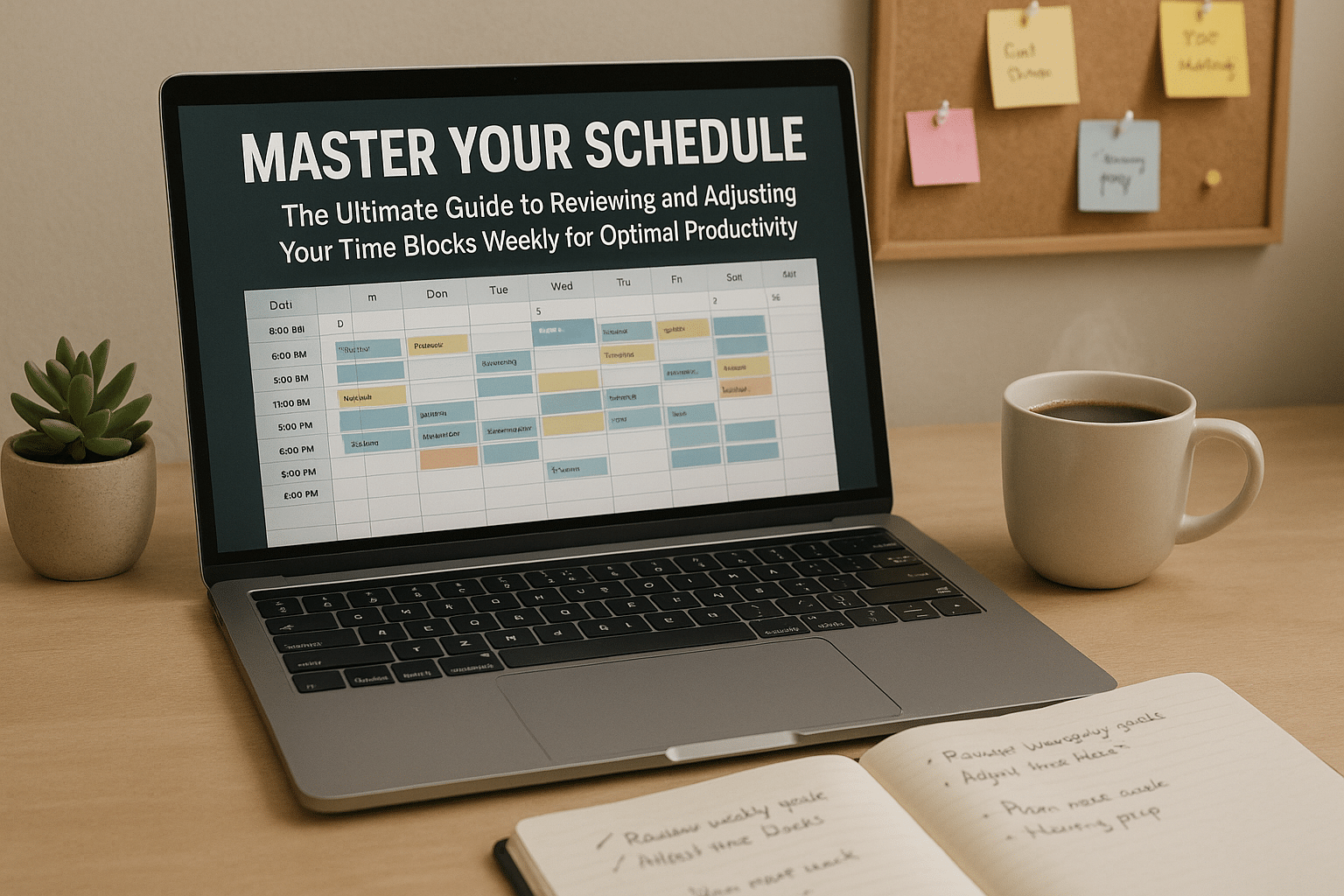Time: it’s one of the few things in life we can’t get more of, no matter how hard we try. ⏳ It’s a universal constant, yet it’s all too easy to feel as if it’s slipping through our fingers, leaving us scrambling to complete tasks, struggling to meet deadlines, and perpetually feeling as if we’re playing catch-up. Sound familiar? If so, you’re in the right place.
Productivity is about more than just ticking items off a to-do list. It’s about achieving your goals in an efficient and effective manner, creating a work-life balance that lets you thrive in both areas, and finding a rhythm that allows you to accomplish more, with less stress and less wasted time. And one of the best ways to boost your productivity is through the power of time blocking.
Time blocking is a time management method that involves scheduling your day into fixed periods of time, or “blocks,” dedicated to specific tasks or activities. Think of it as your day in high definition, where you have a clear view of every task, every deadline, and every goal. 📝 By assigning blocks of time to tasks, you can more effectively manage your time, prioritize your work, and avoid the pitfalls of multitasking and procrastination. But, just like any tool, it’s not enough to simply have it; you need to know how to use it effectively.
The Ultimate Guide to Reviewing and Adjusting Your Time Blocks Weekly for Optimal Productivity
That’s where this guide comes in. Here, we’re going to dive deep into the world of time blocking, offering you the techniques, strategies, and insights you need to master your schedule and supercharge your productivity. We’ll explore the benefits of time blocking, look at how to effectively review and adjust your time blocks, and provide practical tips for making the most of your time.
In the forthcoming sections, you’ll learn about the importance of regular reviews of your time blocks. Regular review is a critical part of any time management strategy, and time blocking is no different. It’s the process of looking back over your time blocks, identifying what worked, what didn’t, and making necessary adjustments. It’s about refining your schedule, tweaking your blocks, and ensuring that your time is being used as effectively as possible. 🔄
But we’re not just going to talk about the what; we’re going to talk about the how. We’ll look at how you can conduct effective time block reviews, and how you can adjust your time blocks to ensure they’re aligned with your goals and priorities. We’ll explore techniques for overcoming common time block challenges, and we’ll share tips and tricks for ensuring your time blocks are helping, not hindering, your productivity.
So, whether you’re a seasoned time blocker looking for a way to fine-tune your technique, a time management newbie eager to take control of your schedule, or someone who just wants to get more done in less time, this guide has something for you. 🎯
Ready to take control of your time and supercharge your productivity? Then let’s dive in!
🎯 Mastering Your Schedule: A Comprehensive Guide
Time management is a skill that has become increasingly critical in our fast-paced world. If you’re like most professionals, you have a list of tasks that seems never-ending. However, with a well-planned and constantly reviewed schedule, you can stay on top of your tasks and increase your productivity. Let’s dive into the details.
This guide will provide you with all the necessary knowledge to structure, review, and adjust your time blocks weekly, ensuring optimal productivity. You’ll discover the benefits of time blocking, the art of reviewing your schedule, and how to make adjustments that align with your priorities. So, grab your planner, digital or paper, and let’s get started.
Before we proceed, take a moment to watch a helpful video by Thomas Frank titled “How to Plan Your Day Effectively” on his YouTube channel. It will provide a comprehensive understanding of how to get the most out of your day.
💡 Understanding the Concept of Time Blocking
Time blocking is a productivity method that involves dividing your day into blocks of time. Each block is dedicated to accomplishing a specific task or group of tasks. It’s about dedicating focus and energy to one thing at a time rather than multitasking.
For a clearer understanding, refer to the following table that illustrates a sample of time blocking:
| Time Block | Tasks |
| 8:00 AM – 10:00 AM | Emails and project planning |
| 10:00 AM – 12:00 PM | Work on project A |
| 12:00 PM – 1:00 PM | Lunch break |
| 1:00 PM – 3:00 PM | Work on project B |
| 3:00 PM – 5:00 PM | Meetings and team coordination |
Benefits of Time Blocking
- It helps prioritize tasks: Time blocking allows you to allocate specific time frames to tasks according to their priority.
- It eliminates multitasking: By focusing on one task within a time block, you avoid the productivity trap of multitasking.
- It gives a realistic view of your schedule: When tasks have a specified time frame, it becomes easier to understand your capacity and manage your schedule effectively.
🔍 The Art of Reviewing Your Schedule
Merely creating a time-blocked schedule isn’t enough. You need to regularly review your schedule to ensure it’s serving your needs and helping you remain productive. The review process involves looking at your completed tasks, evaluating your productivity levels, and noting what’s working and what’s not.
One tool that can assist in this review process is “RescueTime,” an app that provides detailed reports on how you spend your time on tasks. It can be an eye-opener and a fantastic tool to help tweak your schedule for optimal productivity.
Remember to be flexible during your review. If a certain time block consistently proves to be unproductive or stressful, don’t hesitate to adjust it. Consistent evaluation and adjustment can make your schedule work for you, rather than the other way around.
⚙️ Adjusting Your Time Blocks for Optimal Productivity
After reviewing your schedule, the next step is to make adjustments. This involves moving time blocks around to better suit your productivity patterns and workload. Perhaps you find your energy levels are higher in the morning – you could schedule your most demanding tasks for this time.
While making adjustments, consider the following strategies:
- Use your most productive times for your most challenging tasks.
- Ensure to include breaks in your schedule. They are crucial for maintaining sustained productivity and preventing burnout.
- Don’t overpack your schedule. Leave some wiggle room for unexpected tasks or delays.
At this point, you may find it helpful to watch the video “Time Blocking Mastery: Get More Done,” by Michael Hyatt on his YouTube channel. The video provides practical tips on adjusting your time blocks for maximum productivity.
🎁 Bonus: Tools and Resources for Effective Time Blocking
Time blocking is easier and more efficient when you use tools designed for this purpose. Here are a few options:
- Google Calendar: This tool allows you to create events (time blocks) and set reminders.
- Microsoft Outlook: Apart from email, Outlook also has a calendar feature where you can schedule your tasks.
- Todoist: A task management app that enables you to create and schedule tasks, set priorities, and more.
These tools, combined with regular review and adjustment of your schedule, can significantly enhance your productivity. Remember, time blocking isn’t a rigid system. It’s a productivity tool that should be flexible and adaptable to your changing needs and priorities. Make it work for you, and reap the benefits of effective time management.

Conclusion
To conclude, the domain of software engineering and information technology is indeed vast and complex. The intricate interplay of various aspects, from the basics of coding and design, the implementation of algorithms, to the management of databases and software systems, is a world that can be truly fascinating. Throughout this article, we have strived to dissect and understand these complexities, to provide a comprehensive guide to the nuanced realm of software engineering.
We’ve delved into the essence of coding, understanding the importance of various languages like Python, Java, and C++, while also emphasizing on the cruciality of being language agnostic. We’ve explored the role of algorithms, data structures, and operating systems, gaining insight into how they work as the backbone of any software.
Simultaneously, we’ve also touched upon the importance of databases, discussing in detail about SQL and NoSQL systems, their advantages and suitable applications. Furthermore, we’ve also discussed how knowledge of networks and the internet can be beneficial in the IT industry.
A key takeaway from this article should be the realization that being an effective software engineer isn’t just about knowing how to code, but understanding how to solve problems, being able to adapt, and having a deep understanding of the technology stack you are working with.
Now, it’s up to you to take these insights and apply them. Share them with your peers, discuss them in your forums, challenge them if you have different perspectives. Let’s keep the conversation going. 🗣️
The world of software engineering is constantly evolving, so staying up-to-date and continuously learning is not just recommended, it’s essential. Remember, every expert was once a beginner, and every pro was once an amateur. So, take the leap, delve into the details, explore, experiment, and evolve. 🚀
For further reading and references, you can explore the official documentation for Python [HERE](https://docs.python.org/3/), Java [HERE](https://docs.oracle.com/en/java/), and C++ [HERE](https://en.cppreference.com/w/). You can also learn more about databases from [SQL Documentation](https://docs.microsoft.com/en-us/sql/sql-server/?view=sql-server-ver15) and [NoSQL Documentation](https://www.mongodb.com/nosql-explained).
We hope this article has served as a comprehensive guide, helping you navigate the complex landscape of software engineering. Your journey into this field may be challenging, but the rewards are truly fulfilling. Keep learning, keep growing, and most importantly, keep coding. 👨💻👩💻
Thank you for taking the time to read this article. If you have any questions, thoughts, or feedback, please feel free to leave a comment below. We appreciate your participation and look forward to hearing from you! 😊
Until next time, happy coding! 💻



